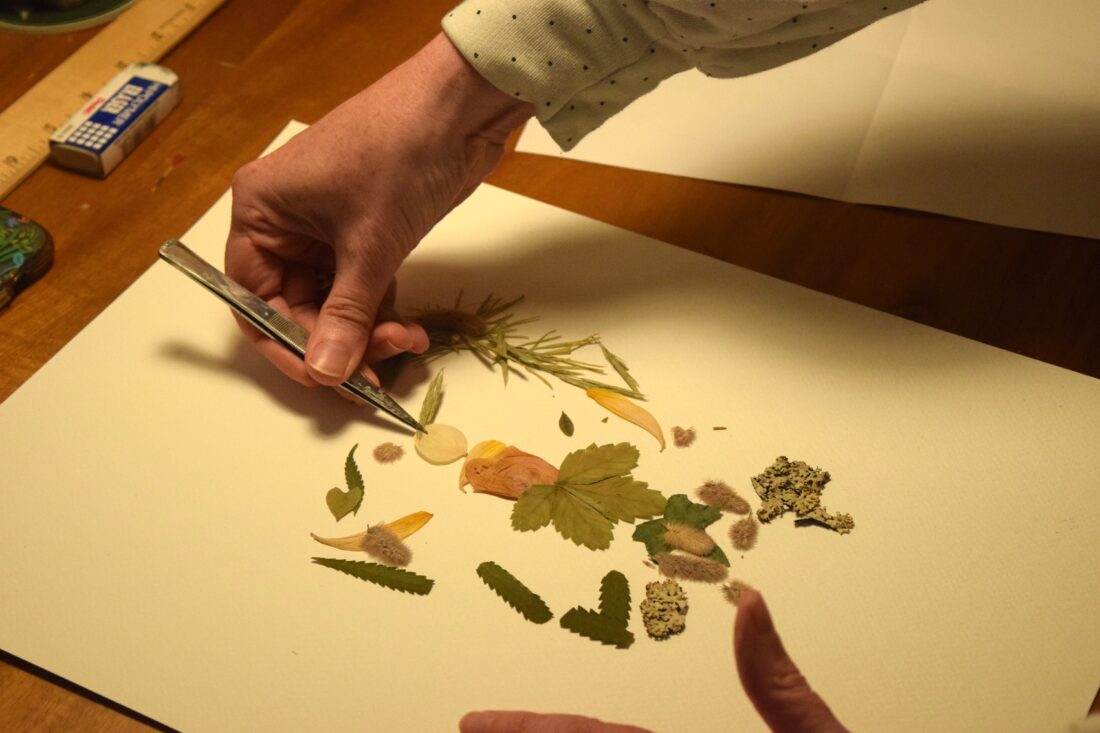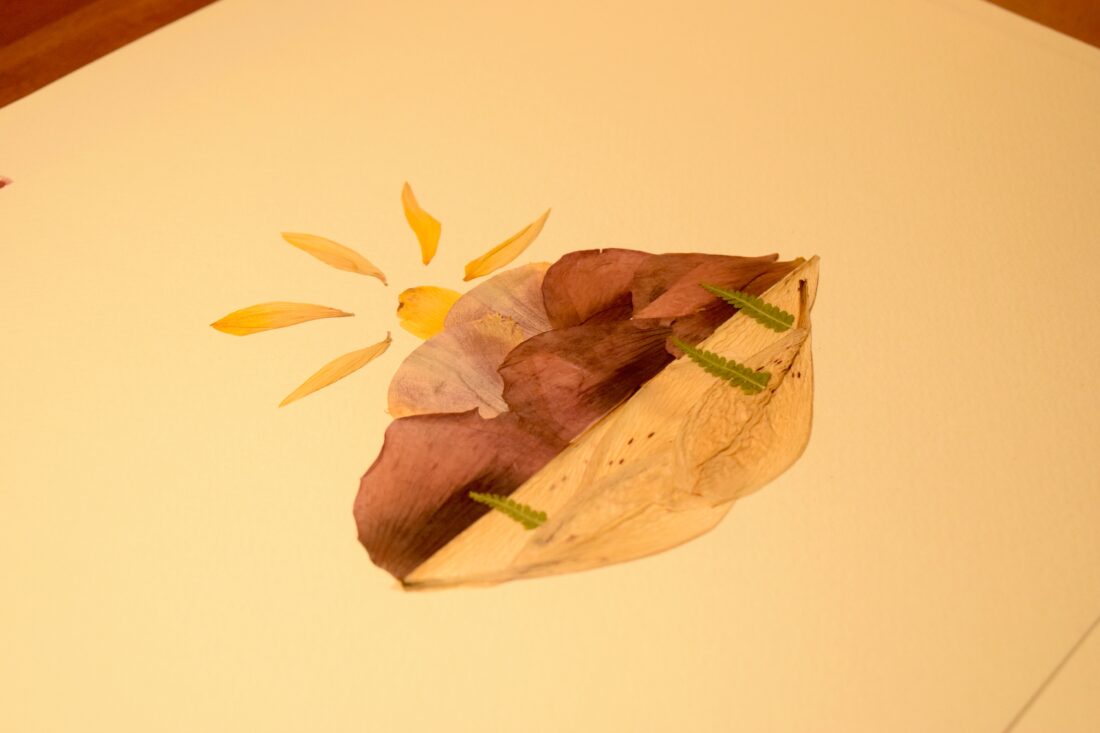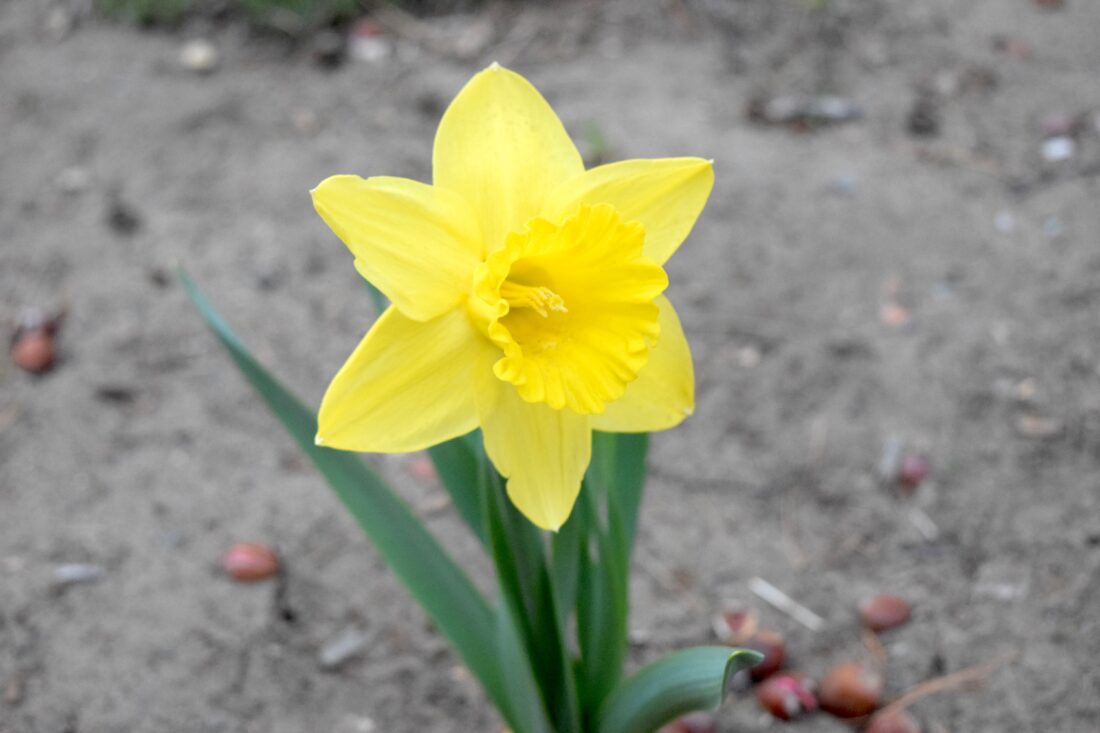ADIRONDACK LIVING: Plant-based art
Olympic Museum director preps botanical art for upcoming show at Tahawus Center

Alison Haas in her Wilmington studio in 2022. (News photo — Lauren Yates)
WILMINGTON — It was a dusky evening on Monday, May 2, but Alison Haas was bursting with color.
Haas was exploring the land around her home in Wilmington, searching for spring flowers — orange and yellow daffodils, sunshiney Forsythia, purple violets — and imagining the art she could make with them.
Haas is an artist who’s always been attracted to color, and her medium provides a rich palette. She makes artwork from pressed flowers, leaves and other botanicals, and on Monday, she was darting from flower to flower as a new season of pressing was blooming.
Haas was naturally drawn to pressing from a young age. She remembers finding four-leaf clovers as a kid growing up and pressing them between pieces of tape to preserve them. She still has some of the clovers in her jewelry box, she said, surprisingly well-preserved. But even though she’s made art throughout her life, she didn’t start creating artistic pressings until adulthood.
Haas, a Potsdam native, said she loved art classes in high school. Her art teacher encouraged her to go to art school for painting, but she ended up going to St. Lawrence University, a liberal arts college in Canton, because she thought she couldn’t have a career in art. She focused on art history and design in graduate school at Kingston University in England, all the while taking more fine arts painting classes.

Plant-based art from Alison Haas, of Wilmington (News photo — Lauren Yates)
Throughout her time in school, Haas said she found multiple sources of visual and artistic inspiration — it just took time for her to realize that painting wasn’t her favorite medium.
“I didn’t love painting, and so it took me a while to discover my love of doing illustrations with pressed flowers, which is not something that was ever taught to me,” she said.
–
Foraging
–

Plant-based art from Alison Haas, of Wilmington (News photo — Lauren Yates)
Haas has a process when it comes to making pressed art pieces. First comes the foraging.
She mostly forages on the nine acres of land that surround her home, and she doesn’t pick just any flower. She’s conscious about the environment, and she never picks flowers by their roots. If there are several flowers in one area, she’ll only pick a couple — especially at this time of year, when bees are starting to emerge and look for food.
“I’m not going to take their food source away from them,” she said.
Haas is also mindful of flowers that are endangered or protected, like the lady slipper or trillium.
Choosing a favorite flower isn’t an easy task. It could change with the season, like a daffodil that blooms only in the early spring. Haas said she has a soft spot for tulips because they press well and retain their color.

Daffodil at the Wilmington home of Alison Haas (News photo — Lauren Yates)
–
Pressing
–
Once Haas has gathered her flowers, she presses them into a wooden press layered with acid-free paper and cardboard until the botanicals are flat, dry and ready to archive for future use.
Haas, who’s the museum director at the Lake Placid Olympic Museum, has come a long way with her preservation techniques since she was a kid sticking four-leaf clovers between two pieces of tape. Now she’s trained in archiving materials, and the art studio in the second-story loft of her home is like a mini museum of perfectly-preserved pressings. Unsurprisingly, she organizes her pressings by color.
Haas has a furniture chest with shallow trays that are filled with individual pressed botanicals. She places similarly-colored pressed pieces on acid-free paper, envelops the paper with an acid-free photography sleeve and organizes those sleeves into the color-coded trays.
Haas is preserving more than flowers when she places them in her press. She’s often preparing a work of art that will preserve memories. She’s gotten into pressing wedding bouquets and creating a pressed piece based on the images she sees from the couple’s wedding day, leaving the couple with an artistic representation of their special day using flowers that might have otherwise been left as refuse.
–
Creating
–
Haas said her work is inspired by a number of things — often what she sees and hears while foraging. She said the sound of a pileated woodpecker could inspire her to look more closely at the bird, or she could be inspired by the sight of a “silly little nuthatch” bird that’s hopping upside down on a tree trunk.
Haas grew up admiring colorful illustrations of fairies, gods, goddesses and other mythical creatures from the books her parents read to her — Greek mythology, Cicely Mary Barker’s Flower Fairies series and Grimm’s fairy tales, to name a few. She also grew up in her mother’s garden, which she said was mostly made up of flowers. The love of fantastical worlds and flowers combine in her pressings, where a tulip petal could become a Flamenco dancer’s skirt or a wasp nest could become the branch on which a cardinal perches.
“Especially with figures, I imagine that they are emerging from these flowers or plants that I’m foraging for along the brook or in the woods, in our gardens,” she said.
Haas said she used to create patterns, like mandalas, with her pressed botanicals, but now she approaches projects with a freer form. She likes to place individual botanicals on the page to see what she can imagine, like someone cloud watching to decipher shapes in the sky.
Once she’s assembled a full piece with loose botanicals on the page, she takes a photo for reference before she wipes the page clean and prepares to glue everything down.
–
Putting it together
–
For Haas, the hardest part of making pressed pieces isn’t finding flowers, pressing them, preserving them or even creating her intricate works of art — it’s gluing all of the delicate botanicals into place on paper. Haas uses tweezers to pick up pressings and place them on the page, and it can be a tedious process when glue is involved. She said if one petal shifts from her original design, it could change the look of the entire piece. She’s got a pile of finished pieces sitting in her studio, but that god-forsaken gluing process is keeping them from their frames.
She said framing flowers is a lot like framing textiles in a museum collection — the frame needs ultraviolet-filtered glass, and pressings have to be kept out of direct sunlight or the vibrant colors could be destroyed.
–
The balance
–
Haas is preparing for a gallery opening at the Tahawus Cultural Center next weekend. She also just finished a 12-week virtual art class on children’s illustration with the New York City School of visual arts. The Lake Placid Olympic Museum is under construction, and Haas is busy redesigning the new facility — expected to be completed toward the end of this year — and working on new exhibits. Between the art course, her gallery opening and her work at the museum, Haas has been staying busy. Oh, and she’s training to run a half marathon.
“It’s all about balancing my time,” Haas said, “and then trying to be a mom also.”
Throughout the busy times, pressing has been a source of “art therapy” for Haas. She said it’s a way of finding joy in life.
“It’s a way for me to just zen out and do something for myself that I just get a lot of joy from, and I’m able to extend that joy to others.”
Her artwork will be on display at the Tahawus Cultural Center from May 14 to June 26 as part of the “Wild at Heart” multi-media show, along with art by Rachel Finn and Susan Burdick Young. People can see her art by appointment or during the center’s open hours every Saturday from 1 to 2:30 p.m. There will be an opening ceremony at the gallery from 4:30 to 6:30 p.m. on May 14.
People who want to attend the opening are encouraged to RSVP by phone, 646-734-0703, or by email, tahawuscenter@gmail.com.





